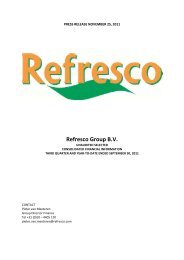measure and monitor the processes and report results ... - Refresco.de
measure and monitor the processes and report results ... - Refresco.de
measure and monitor the processes and report results ... - Refresco.de
You also want an ePaper? Increase the reach of your titles
YUMPU automatically turns print PDFs into web optimized ePapers that Google loves.
Hedge of a net investment in a foreign operation<br />
Translation differences on intragroup longterm loans that<br />
effectively constitute an increase or <strong>de</strong>crease in a net investment<br />
in a foreign operation are recognized in o<strong>the</strong>r comprehensive<br />
income in <strong>the</strong> reserve for translation differences.<br />
2.3 Financial instruments<br />
Non<strong>de</strong>rivative financial instruments<br />
Non<strong>de</strong>rivative financial instruments comprise investments in<br />
heldtomaturity investments, tra<strong>de</strong> <strong>and</strong> o<strong>the</strong>r receivables, cash<br />
<strong>and</strong> cash equivalents, loans <strong>and</strong> borrowings, <strong>and</strong> tra<strong>de</strong> <strong>and</strong><br />
o<strong>the</strong>r payables.<br />
Non<strong>de</strong>rivative financial instruments are recognized initially at<br />
fair value plus, for instruments not at fair value through profit<br />
or loss, any directly attributable transaction costs. Subsequent<br />
to initial recognition, non<strong>de</strong>rivative financial instruments are<br />
<strong>measure</strong>d as <strong>de</strong>scribed below.<br />
Cash <strong>and</strong> cash equivalents comprise cash balances, checks in<br />
transit <strong>and</strong> call <strong>de</strong>posits. Bank overdrafts that are repayable<br />
on <strong>de</strong>m<strong>and</strong> <strong>and</strong> form an integral part of <strong>the</strong> cash management<br />
<strong>processes</strong> are inclu<strong>de</strong>d as a component of cash <strong>and</strong> cash<br />
equivalents for <strong>the</strong> purpose of <strong>the</strong> cash flow statement.<br />
The accounting for finance income <strong>and</strong> expense is <strong>de</strong>scribed<br />
in note 2.17.<br />
Heldtomaturity investments<br />
If <strong>the</strong> Group has <strong>the</strong> positive intent <strong>and</strong> ability to hold <strong>de</strong>bt<br />
securities to maturity, <strong>the</strong> securities are classified as heldtomaturity.<br />
Heldtomaturity investments are <strong>measure</strong>d at<br />
amortized cost, using <strong>the</strong> effective interest method, less any<br />
impairment losses.<br />
Derivative financial instruments<br />
The Group holds <strong>de</strong>rivative financial instruments to hedge<br />
its foreign currency <strong>and</strong> interest rate risk exposures.<br />
Derivatives are recognized initially at fair value <strong>and</strong> attributable<br />
transaction costs are recognized in profit or loss when incurred.<br />
Subsequent to initial recognition, <strong>the</strong> <strong>de</strong>rivatives are <strong>measure</strong>d<br />
at fair value. All changes in its fair value are recognized<br />
immediately in profit or loss. Where <strong>the</strong> financial instruments<br />
are held to hedge foreign currency purchases of raw materials<br />
<strong>and</strong> consumables, <strong>the</strong> changes are inclu<strong>de</strong>d in raw materials<br />
<strong>and</strong> consumables used. Where <strong>the</strong> instruments are held to<br />
hedge interest rate risk exposure, <strong>the</strong> changes are inclu<strong>de</strong>d in<br />
finance income <strong>and</strong> expense.<br />
Loans <strong>and</strong> receivables<br />
Loans <strong>and</strong> receivables are non<strong>de</strong>rivative financial assets with<br />
fixed or <strong>de</strong>terminable payments that are not quoted in an<br />
active market. They are carried at amortized cost using <strong>the</strong><br />
effective interest<br />
method, less any impairment losses. They are inclu<strong>de</strong>d in<br />
current assets, except for loans <strong>and</strong> receivables with maturities<br />
greater than 12 months after <strong>the</strong> balance sheet date.<br />
2.4 Share capital<br />
Ordinary share capital<br />
Ordinary share capital is classified as equity. Incremental costs<br />
directly attributable to <strong>the</strong> issue of ordinary shares <strong>and</strong> share<br />
options are recognized as a <strong>de</strong>duction from equity, net of any<br />
tax effects.<br />
Preference share capital<br />
Preference share capital is classified as equity if it is nonre<strong>de</strong>emable,<br />
or re<strong>de</strong>emable only at <strong>the</strong> Company’s option,<br />
<strong>and</strong> any divi<strong>de</strong>nds are discretionary. Divi<strong>de</strong>nds <strong>the</strong>reon are<br />
recognized as distributions within equity upon approval by<br />
<strong>the</strong> General Meeting of Sharehol<strong>de</strong>rs.<br />
2.5 Non-controlling interest<br />
Noncontrolling interest are recognised initially at <strong>the</strong>ir share<br />
of <strong>the</strong> i<strong>de</strong>ntifiable assets, liabilities <strong>and</strong> contingent liabilities<br />
recognised in <strong>the</strong> purchase accounting, excluding goodwill.<br />
Subsequently <strong>the</strong> allocation of profits between <strong>the</strong> parent<br />
<strong>and</strong> noncontrolling interest are based on <strong>the</strong> indirect method,<br />
whereby <strong>the</strong> amount allocated to noncontrolling interest<br />
represents <strong>the</strong>ir net effective interest in subsidiary.<br />
page _ 66 / 67







